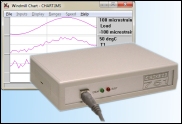Monitor - ISSN 1472-0221
The Newsletter for PC-Based Data Acquisition and Control
Issue 242, November 2018
Welcome to Monitor - thanks for subscribing. Any comments or questions email monitor@windmillsoft.com.
You can download this issue as a pdf file from https://www.windmill.co.uk/monitor/monitor242.pdf.
Contents
* Why and When to Calibrate Meaurement Instruments
* Your DAQ Questions Answered
* Data Acquisition News Round-Up
Why and When to Calibrate Measurement Instruments
Web Link: https://www.windmill.co.uk/drift-recalibration.html
Measurement and control devices are delivered tested and calibrated to international standards. Over time, though, they will lose their accuracy and measurements will "drift".
Drift is a slow variation of a performance characteristic such as gain or offset.An offset drift results in a reading other than zero, for a zero condition. A gain drift is an error multiplied by the measured value. A gain drift of +/-0.05%, for example, means that the measurement will be out by 0.05%.
Drift is due to ageing components or environmental changes: such as changes in temperature or humidity. It is especially significant when you are measuring low-level signals (a few microvolts) over long periods of time, or in difficult environmental conditions.
The way to deal with drift is to re-calibrate the instrument periodically. Calibration compares the instrument's actual performance to an accuracy standard. To do this you may need to return the instrument to the manufacturer or receive an on-site visit from them. You will then receive a calibration certificate which will be valid until the next recommended calibration date, often a year later. The higher the accuracy required, the more frequently the instrument will need to be calibrated.
Some instruments, like many in our Microlink range, are able to re-calibrate themselves periodically. They measure a reference voltage and compensate for offset and gain drifts.
Self-calibration is useful for long term monitoring since drifts do not accumulate. You need to be careful not to set the re-calibrations too far apart as this can lead to small discontinuities in the recorded data as the re-calibrations occur.
Further Reading
Measurement devices which auto-recalibration
Your Data Acquisition Questions Answered
Question
I am interested in the Microlink 751-SG or 851-SG for strain gauge logging. Information mentions you supply precision 350 ohm resistors for quarter bridge configurations, but I can't find them on web site. How much are they and how do I order them? Thanks
Answer
The precision resistors are included in the price of the 751-SG and 851-SG strain gauge logging units. We will usually configure the unit with the required resistors for you (two 1 kOhm termination resistors mounted in half bridge configuration or 350 and 120 Ohm resistors for the completion of quarter bridges), although if you prefer to do it yourself you can do so.

More details of our strain gauge logging options are at https://www.windmillsoft.com/daqshop/strain-measurement.html
DAQ News Round-up
Welcome to our round-up of the data acquisition and control news. If you would like to receive more timely DAQ news updates then follow us on Twitter - @DataAcquisition - or grab our rss feed.
Gravity measurement sensors map subterranean environment
New quantum cold-atom sensors will detect and monitor objects beneath the ground better than existing technology, reducing the need for time-consuming and disruptive drilling or digging, according to Gravity Pioneer project.
Source: The Enginer
https://www.theengineer.co.uk/
Handheld sensor precisely measures crop health
The device scans a plant for physiological features, such as moisture, nutrient and chlorophyll levels, as well as different chemical spraying effects and disease symptoms to determine whether it is healthy or under stress.
Source: Purdue University
https://www.purdue.edu/
New composite material regulates its temperature
A cutting-edge material, inspired by nature, can regulate its own temperature and could equally be used to treat burns and help space capsules withstand atmospheric forces.
Source: Nottingham University
https://www.nottingham.ac.uk/
* Copyright Windmill Software Ltd
* Reprinting permitted with this notice included
* For more articles see https://www.windmill.co.uk/
We are happy for you to copy and distribute this
newsletter, and use extracts from it on your own web
site or other publication, providing the above notice
is included and a link back to our website is in place.
For previous issues by subject see https://www.windmill.co.uk/monitorindex.html
SUBSCRIBING OR CANCELLING SUBSCRIPTION Visit https://www.windmill.co.uk/newsletter.html and add or remove your e-mail address.
Windmill Software Ltd, PO Box 58, North District Office,
Manchester, M8 8QR, UK
Telephone: +44 (0)161 834 6688
Facsimile: +44 (0)161 833 2190
E-mail: monitor@windmillsoft.com
https://www.windmill.co.uk/
https://www.windmillsoft.com/
